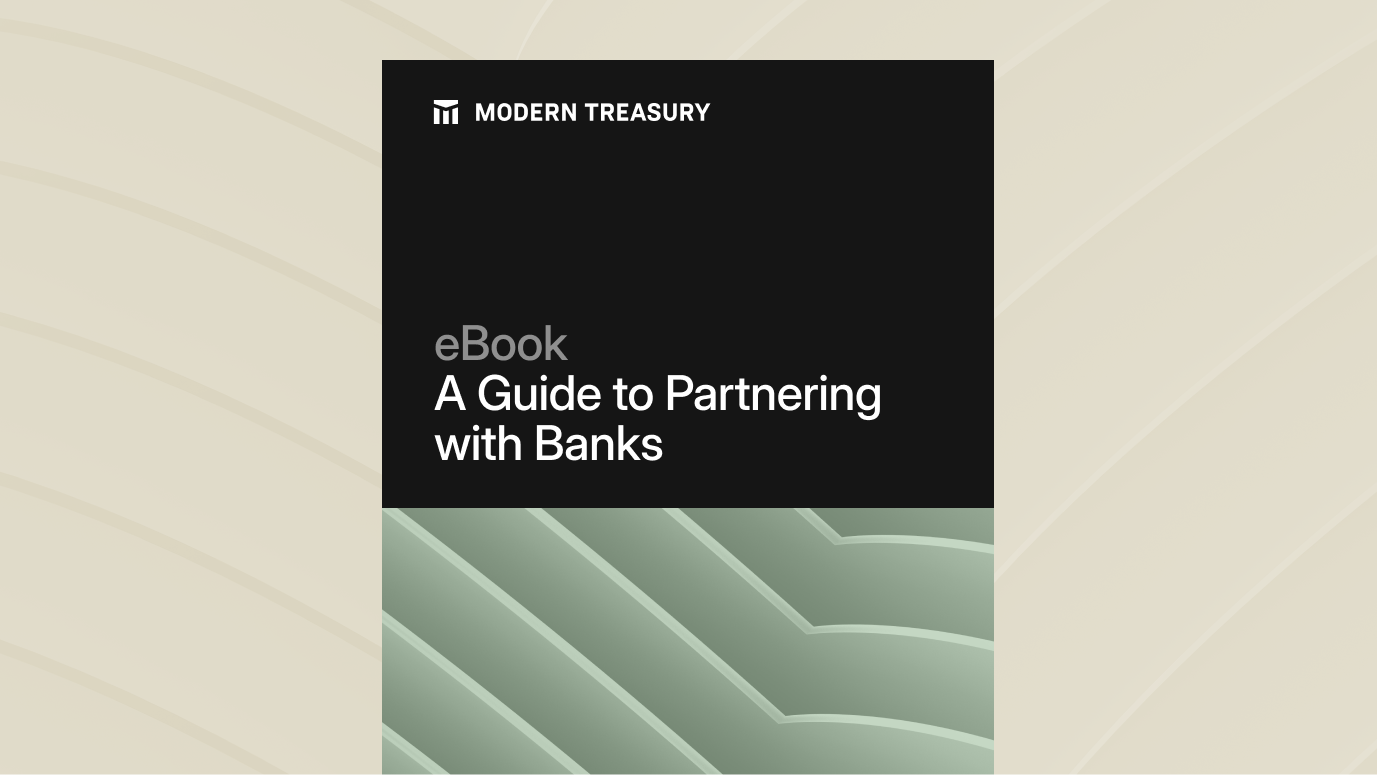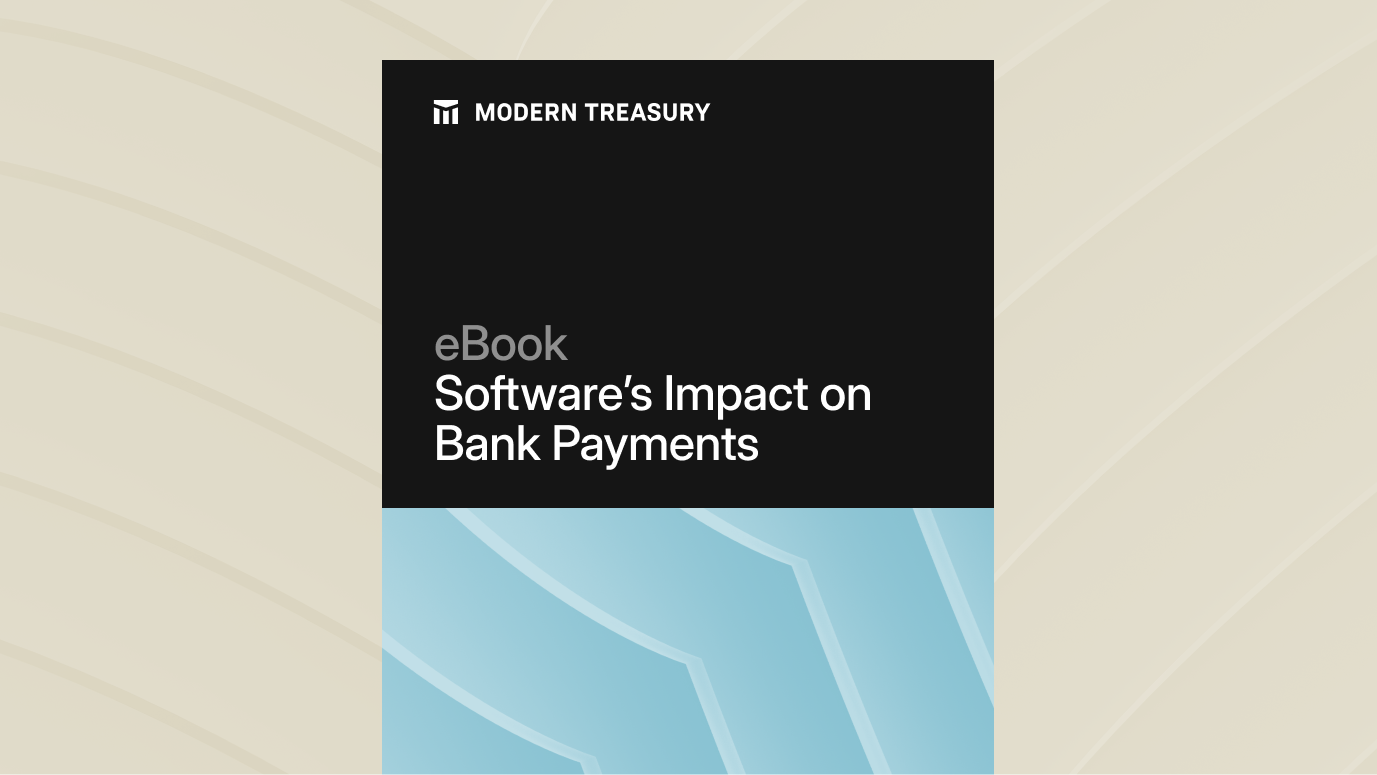Join us at Transfer 2025 to hear how industry leaders are building payments infrastructure for a real-time world.Register Today →
Why You Should Own Your Bank Relationship
Building sustainable companies takes work. For companies with high-volume, complex payment workflows, Modern Treasury believes the key to longevity is owning your banking relationship. Here, we dig into the costs and benefits of doing so.

Over the years, companies have often asked us about the operational complexity of managing a payments program, and why we recommend companies sit in the flow of funds. The answer boils down to this: companies that sit in the flow of funds own banking relationships fully, and have a more scalable, resilient, and ultimately cost-effective foundation on which to grow a sustainable business. In this journal, we’ll explain why.
A Brief Refresher on the Flow of Funds
When we talk about the “flow of funds,” we’re talking about the one or more “hops” the money takes on its way from the sending bank account to the receiving bank account. When your business sits in the flow of funds, it means that one of the hops from source to destination touches your business’ bank account.
Let’s illustrate with a quick example: say your company is DeskAnywhere, a short-term rental marketplace that sells unoccupied office spaces to companies whose employees are traveling to locations where they don’t have a corporate presence. When a business rents an office space for a week, they authorize DeskAnywhere to charge them for the expense (the first hop from the Renter’s account to your bank account), then DeskAnywhere sends the money to the Office Owner (the second hop from your account to the owner’s).
Sitting in the flow of funds also means you’ll have to do some work up-front, namely get integrated with your banking partner.
Up-Front Cost with Downstream Benefits
Set Up Cost
There are three major steps to setting up your banking relationship:
- Finding a bank partner: Moving money directly through your platform requires having an existing bank relationship. If you don’t have a bank partner or are looking for a new one, Modern Treasury can help guide you through the bank onboarding process with one of our many bank partners.
- Understanding money transmission regulations: Some business models are subject to money transmission regulations. These rules are set up to prevent money laundering, and vary at the state and federal level. To comply, you’ll either need to apply for a money transmitter license or get an exemption. We recommend getting guidance from your legal counsel to determine the right path forward for your business.
- Integrating with your bank: To move money through your bank partner, you’ll need a way to pass payment information to and from the bank. Traditionally, this step has been expensive and time-consuming because it would require engineers to build custom integrations against each bank. Modern Treasury has a unified payments API that provides out-of-the-box bank integrations and operational workflows so that you can quickly enter the flow of funds without needing to build from scratch.
Downstream Benefits
The benefits of owning your banking relationship dovetail with the benefits of sitting in the flow of funds:
- More control. Owning your banking relationship and limiting third party interference gives you ultimate control over your cashflow. When third parties are introduced—to process payments or perform other banking responsibilities—they often bring their own compliance programs to manage risk. That means they could force their limits, payment schedules, and other requirements onto your business. When you build your own compliance program, you can create rules around money movement better tailored to your business and customer needs. Paired with the right operational tools—like approval rules—they can also anticipate and manage payment issues more proactively. Read more about how Masterworks’ finance team streamlined their money management.
- Less risk. The complement to the above benefit, when you build your own compliance program (though you assume liabilities for transactions), you often build more robustly and for longevity. Once again, when you are at the mercy of third party compliance programs, you become subject to their rules. In some cases, you may even risk entering a structure in which your business’ money is commingled in a single account with other businesses’ money—with no traceable way for you to discern or communicate discrete balances for your customers. In worst cases, they could freeze your funds or limit your access to your cash.
- Speed to market. Setting up an embedded payment product is easy when you own your banking relationship, because you have clarity on all the accounts involved in each transaction. Setting up FBO accounts with accompanying ledger databases can help you to manage and track customer funds down to the cent. Plus, your banking partners could even facilitate setting your product up for success. Find out how Procore launched Procore Pay with Goldman Sachs and Modern Treasury.
- Faster payouts. When funds pass through an intermediary account before reaching their final destination, it can add days to the payment flow (the initial wait for funds to settle in the third-party’s bank account, and then another several days for funds to reach its destination). For more on this, check out our case study with Outdoorsy.
Modern Treasury’s Model
Modern Treasury is building financial infrastructure for the future. While we’ve never been an intermediary in the flow of funds, we make it easy for our customers to sit in the flow of funds and own their banking relationship. We do this in a couple of ways:
Pure Software
Modern Treasury is an operating system that moves, tracks, and reconciles payments in real-time with pure software. Our suite of APIs and customizable UI tools can be configured in many ways to fulfill multiple needs for payments at scale, and beyond. With our reconciliation engine, customers can be confident that their money is getting to where it needs to, on time, every time, without the need to decipher multiple payment files and bank statements.
Breadth of Bank Partners
Nearly six years ago, our wedge into the market was a payments API, with which we integrated into many banks to enable seamless money movement. We’ve grown our product offering since then, and our deep understanding of these banks and the semantics of communicating payment information with them has grown, also.
The banks in our network are stable, top-tier banks, with whom we’ve fostered great relationships. We recommend a multi-bank solution for our customers to build resiliency; that way, in the case of black swan events such as a bank failure, our customers can quickly maneuver their fund flows to another bank with a single line of code.
Find out more
For companies with complex money flows or ones that move money at high-volumes, owning your bank relationship is our recommendation for a sustainable and scalable business. If you want to learn more about how we work, or have other questions, reach out to us.
Try Modern Treasury
See how smooth payment operations can be.







